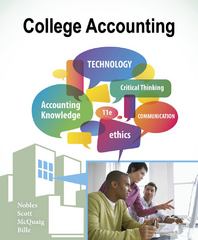Question
Anew piece of equipment costs $18,000 with a residual value of $600 and an estimated useful life of five years. Assuming twice the straight-line rate,
Anew piece of equipment costs $18,000 with a residual value of $600 and an estimated useful life of five years. Assuming twice the straight-line rate, the book value at the end of Year 2 using the declining balance method is
3. Cost of merchandise sold equals beginning inventory A. plus net purchases plus ending inventory. B. minus net purchases plus ending inventory. C. minus net purchases minus ending inventory. D. plus net purchases minus ending inventory.
4. Which one of the following does not depreciate? A. Computer B. Truck C. Building D. Land
5. Achbar Corporation has earned $175,900 after tax. The accountant calculated the return on equity as 12.5%. Achbar Corporation's stockholders' equity to the nearest dollar is A. $14,720. B. $140,720. C. $1,407,200. D. $140,720,000.
6. Open-end credit in a revolving charge plan results in A. as many charged purchases till credit limit is reached. B. as many cash purchases till credit limit is reached. C. one purchase per month. D. the U.S. Rule being applied to each purchase.
7. A variable rate mortgage means A. the interest rate is not fixed. B. the rate is not subject to change. C. the interest rate is fixed for five years. D. larger monthly payments than a fixed rate.
8. Lydia bought a home for $140,000. She put 20% down with a mortgage rate of 7.5% for 25 years. What are her yearly payments? (Use Table 15.1 in the textbook for the factor.) A. $9,932.16 B. $12,415.20 C. $9,329.61 D. $1,776.00
9. Amount financed is equal to cash price _______ down payment. A. minus B. divided by C. times D. plus
10. In calculating the daily balance, cash advances are A. sometimes subtracted out. B. always added in. C. always subtracted out. D. sometimes added in.
11. Andrew invests $9,000 at the end of each year for 20 years. The rate of interest Andrew gets is 8% annually. Using the tables found in the textbook, determine the final value of Andrew's investment at the end of the twentieth year on this ordinary annuity. A. $88,362.90 B. $88,632.90 C. $411,858.00 D. $411,588.00
12. Graduated payments result in the borrower paying A. the mortgage at the standard rate. B. more at the beginning of the mortgage. C. less at the end of the mortgage. D. less at the beginning of the mortgage.
13. Jamie purchased a condo in Naples, Florida, for $699,000. She put 20% down and financed the rest at 5% for 35 years. What are Jamie's total finance charges? A. $457,425.60 B. $600,000.00 C. $606,823.20 D. $626,863.20
14. What is true of a sinking fund? A. It doesn't compound its money. B. It aids in meeting a future obligation. C. It's not really an annuity. D. It requires one lump sum payment at the beginning.
15. Bayani is charged 2 points on a $120,000 loan at the time of closing. The original price of the home before the down payment was $140,000. How much do the points in dollars cost Bayani? A. $4,200 B. $2,800 C. $2,400 D. $8,200
16. A new piece of equipment costs $18,000 with a residual value of $600 and an estimated useful life of five years. Assuming twice the straight-line rate, the book value at the end of Year 2 using the decliningbalance method is A. $6,480. B. $18,000. C. $7,200. D. $11,520.
17. Depreciation expense is located on the A. balance sheet. B. income statement. C. accounts payable documentation. D. accounts receivable documentation.
18. Don made deposits of $500 at the end of each year for eight years. The rate is 8% compounded annually. Using the tables found in the textbook, calculate the value of Don's annuity at the end of eight years. A. $4,318.30 B. $2,873.30 C. $2,837.03 D. $5,318.30 End of exam
19. Justin Chan bought a Scion car for $8,200, putting down $800 and financing the remainder with 60 monthly payments of $179.99. Using the tables found in your textbook, the APR by table lookup is A. Close to 15 percent B. Close to 14 percent C. Between 16.00 and 16.25 percent D. Close to 13 percent
20. The acid test ratio does not include A. cash. B. accounts receivable. C. inventory. D. supplies.
Step by Step Solution
There are 3 Steps involved in it
Step: 1

Get Instant Access to Expert-Tailored Solutions
See step-by-step solutions with expert insights and AI powered tools for academic success
Step: 2

Step: 3

Ace Your Homework with AI
Get the answers you need in no time with our AI-driven, step-by-step assistance
Get Started


